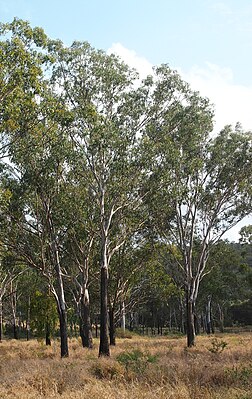Eucalyptus cambageana
| Eucalyptus cambageana | ||||||||||||
|---|---|---|---|---|---|---|---|---|---|---|---|---|

Eucalyptus cambageana |
||||||||||||
| Systematics | ||||||||||||
|
||||||||||||
| Scientific name | ||||||||||||
| Eucalyptus cambageana | ||||||||||||
| Maiden |
Eucalyptus cambageana is a species ofthe myrtle family (Myrtaceae). It occurs in the center and in the east of Queensland and is called there "Blackbutt", "Dawson River Blackbutt", "Dawson Gum" or "Coowarra Box".
description
Appearance and leaf
Eucalyptus cambageana grows as a tree that reaches heights of 15 to 25 meters and a crown diameter of 5 to 15 m. The bark remains on the lower part of the trunk, is gray, gray-black or black and fibrous-lumpy with whitish spots. There are oil glands in both the bark and the marrow of the young branches.
In Eucalyptus cambageana , heterophyllia is present. The leaves are always divided into a petiole and a leaf blade. On young and middle-aged specimens, the leaf blade is 8 to 15 cm long and 2.5 to 3.5 cm wide, lanceolate to ovoid, straight, with entire margins and a dull gray-green. The leaf stalks on adult specimens are narrowly flattened or channel-shaped. The leaves of the same color on the top and bottom of the adult specimens are dull gray-green and are 10 to 18 cm long and 2 to 3 cm wide, narrow-lanceolate or lanceolate, curved sickle-shaped and relatively thick; they can taper towards the base of the blade or be rounded there and their upper end can be pointed or blunt. The raised lateral nerves extend from the median nerve at an acute angle. The cotyledons ( cotyledons ) are wrong kidney-shaped.
Inflorescence and flower
At the end of an inflorescence shaft with a square cross-section, there are approximately three to seven-flowered partial inflorescences in compound total inflorescences . The flower buds are obovate or club-shaped and not floured or frosted blue-green. The sepals form a calyptra that falls off early. The smooth calyptra is hemispherical or conical, as long and as wide as the smooth flower cup (hypanthium). The flowers are white or creamy white.
fruit
The fruit is conical or pear-shaped. The disc is indented, the fruit compartments are included.
Occurrence
The natural range of Eucalyptus cambageana is in the center and in the east of Queensland .
Eucalyptus cambageana grows in scrubland and in light forests together with “Brigalow” ( Acacia harpophylla ), “Belah” ( Casuarina cristata ) and “Wilga” ( Geijera parviflora ). These sparse forests, in which Eucalyptus cambageana dominates together with “Brigalow”, can be found on clay soils , on watercourses and over sedimentary rocks .
In central Queensland, the appearance of Eucalyptus cambageana is a sign of the salinisation of the soil, which has a negative impact on the yield of agricultural land.
Taxonomy
The first description of eucalyptus cambageana was made in 1913 by Joseph Maiden under the title Notes on Eucalypts (with discriptions of new species) No. 1 in Journal and Proceedings of the Royal Society of New South Wales , Volume 47 (1), p. 91. The type material is labeled “ Type from Mirtna Station, Charters Towers, Queensland (Miss Zara Clark, January and December 1912.) " on. The specific epithet cambageana honors the Australian surveyor and botanist Richard Hind Cambage (1859–1928).
use
The wood of Eucalyptus cambageana is very heavy and is used for fence posts. Eucalyptus cambageana grows too big for private gardens, but looks beautiful in public green spaces due to its high-contrast bark.
Individual evidence
- ↑ a b Specimen search results: Eucalyptus cambageana at Australia's Virtual Herbarium. Council of Heads of Australasian Herbaria . Retrieved April 9, 2013
- ↑ a b c APNI = Australian Plant Name Index . Center for Plant Biodiversity Research. Australian Government. Retrieved April 9, 2013
- ↑ a b c d e f g Eucalyptus cambageana at EucaLink - A Web Guide to the Eucalypts . Retrieved April 9, 2013.
- ↑ a b c d e Rodger W. Elliot, David L. Jones, Trevor Blake: Encyclopaedia of Australian Plants Suitable for Cultivation. Volume 4: Eu – Go. Lothian Press, Port Melbourne 1992, ISBN 0-85091-213-X , p. 16. The author of the article had the source in the en-Wikipedia.
- ^ Flora - Queensland - Central West . In: Len Webb Ecological Images Collection . Griffith University. Archived from the original on April 14, 2012. Info: The archive link was inserted automatically and has not yet been checked. Please check the original and archive link according to the instructions and then remove this notice. Retrieved April 9, 2013.
- ^ Department of Environment and Heritage Protection: Regional ecosystem details for 10.4.3 . In: Wildlife and Ecosystems . Queensland Government. 2012. Retrieved April 9, 2013.
- ^ Department of Environment and Heritage Protection: Regional ecosystem details for 10.3.3 . In: Wildlife and Ecosystems . Queensland Government. 2012. Retrieved April 9, 2013.
- ^ Department of Environment and Heritage Protection: Regional ecosystem details for 11.9.1 . In: Wildlife and Ecosystems . Queensland Government. 2012. Retrieved April 9, 2013.
- ↑ Irvine, SA; Doughton, JA: Salinity and Sodicity, Implications for Farmers in Central Queensland . In: Australian Society of Agronomy . The Regional Institute Ltd. 2001. Retrieved April 9, 2013.
- ↑ Entry in Tropicos . Retrieved April 9, 2013
- ↑ Rafaël Govaerts (ed.): Eucalyptus cambageana. In: World Checklist of Selected Plant Families (WCSP) - The Board of Trustees of the Royal Botanic Gardens, Kew . Retrieved March 15, 2013.